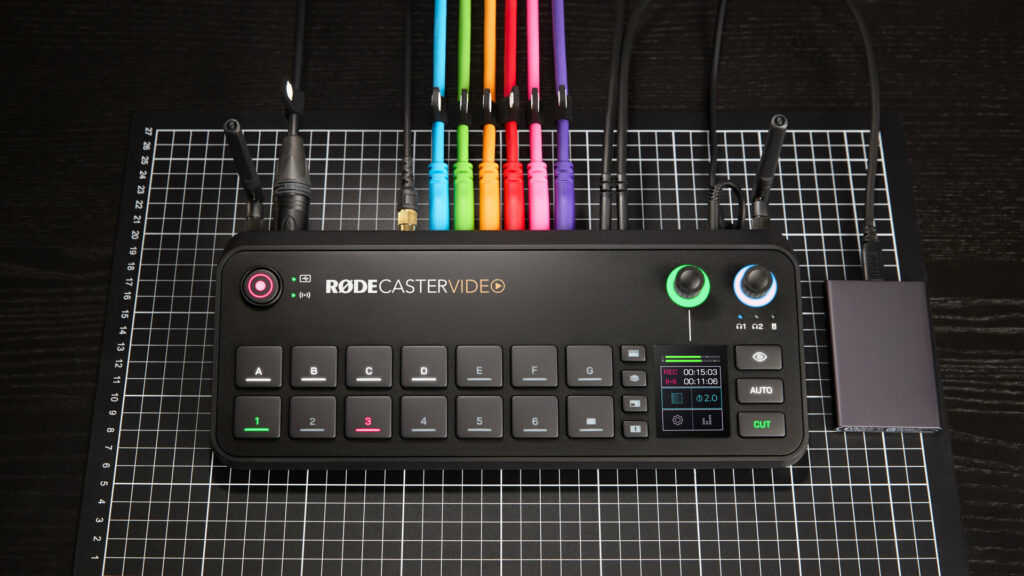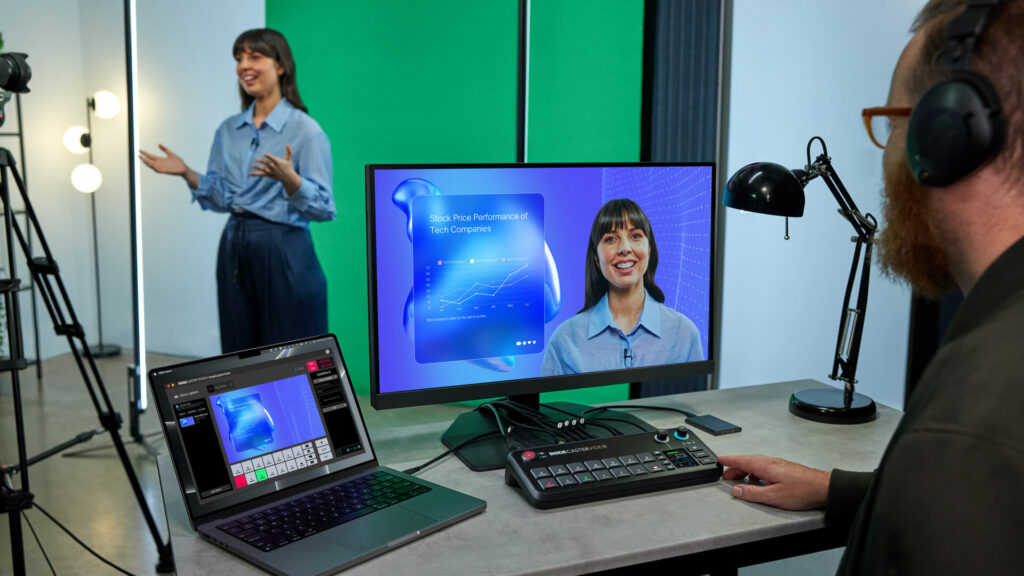Introducing the RODECaster Video: A Game-Changer for Event Video, Livestreaming, and Podcast Production
Note: affiliate purchasing links are used in this article, from which we earn a small commission at no cost to you.

Today, RØDE launched the RODECaster Video, an all-in-one production console designed for multi-camera event video production, live streaming, and podcasting. Building on the popularity of the RODECaster Pro series, this versatile switcher/audio mixer combo brings several innovative features to the table, positioning it as a powerful alternative to competing models like the Blackmagic ATEM Mini Pro and Extreme models. As heavy users of the ATEM series ourselves, we’ll look at what the RODECaster Video offers, key comparisons with ATEM models, and how it could enhance the professional services offered by companies like Innobella Media.
Features and Initial Impressions
The RODECaster Video combines advanced video switching, audio mixing, and seamless control in a sleek, portable package. At first glance, it stands out for its balanced audio inputs, WiFi capabilities, automatic camera-switching based on microphone input, and compatibility with RODE wireless microphones. These features are aimed at reducing setup complexity and allowing creators and professionals to produce high-quality content with ease. Here’s a closer look at some standout elements.

Balanced XLR Inputs
One of the RODECaster Video’s most practical advantages over the ATEM Mini Pro and Extreme is its inclusion of balanced XLR audio inputs. The ATEM models only offer unbalanced 3.5mm jack inputs, which limits compatibility with many professional audio sources. For instance, professional audio desks generally output balanced signals via XLR, and integrating these with an ATEM requires a DI box to convert balanced to unbalanced audio. This setup, while functional, adds unnecessary complexity and potential points of failure. With the RODECaster Video’s two XLR ports, sound engineers may finally find the streamlined solution they’ve been looking for.
An open question remains: can these XLR inputs be used together for a stereo input signal? If so, this would further expand the flexibility of the device, making it even more attractive to pros looking to simplify their rig without sacrificing audio quality.
Built-In WiFi

While an Ethernet connection is typically the preferred choice for livestreaming events (as we advise for Innobella Media’s live streaming services), RODE has acknowledged the reality of varied production environments by including WiFi connectivity. In venues lacking Ethernet access, WiFi opens up new possibilities for flexibility.
For instance, with the ATEM Mini, you’d likely need workarounds such as adapters or additional hardware to access WiFi, which isn’t ideal for seamless, reliable streaming. By integrating WiFi directly, RODECaster Video minimizes these frustrations and allows sound engineers to confidently tackle live streaming even in less predictable locations.
Automatic Camera Switching Based on Microphone Input

One of the most intriguing features on the RODECaster Video is its ability to automatically switch video inputs based on the active microphone input. For video podcasts, stage panel discussions, or even small conferences, this feature enables a new level of automation, which can reduce staffing needs or free up team members to focus on other tasks.
That said, it’s important to note that this functionality appears to be limited to microphones connected directly to the RODECaster Video, rather than integrating with other devices like the RODECaster Pro II. Expanding compatibility via firmware update to include external audio sources, such as the five mic inputs on the RODECaster Pro II, could make this feature a true game-changer for podcasting and live-event production setups.
Built-In Wireless Receiver
Another highlight of the RODECaster Video is its compatibility with RODE’s wireless microphones, providing a completely cable-free option for events, conferences, and training sessions. By eliminating cable clutter and simplifying the setup process, this feature has the potential to streamline workflows in complex event settings. Fewer cables mean fewer potential failures, which is always a benefit when working in time-sensitive and high-stakes environments.
Comparison with Blackmagic ATEM Mini Pro and Extreme
While the ATEM Mini series, especially the Pro and Extreme models, are reliable and versatile video switchers, they come with some limitations for sound-focused professionals. Here’s a side-by-side look at some key differences:
| Feature | RODECaster Video | ATEM Mini Pro/Extreme |
|---|---|---|
| Audio Inputs | 2 XLR balanced inputs | 3.5mm unbalanced inputs |
| Wireless Mic Receiver | Built-in (RODE wireless compatibility) | No |
| WiFi | Yes | No (wired Ethernet only) |
| Auto Camera Switching | Yes, based on mic input | No |
| Video Inputs | Multiple HDMI inputs | Multiple HDMI inputs |
| Additional Features | Combined audio/video control, portable | Excellent for basic switching setups |
The ATEM Mini Pro and Extreme do offer excellent multi-camera video switching capabilities and are staples in the industry. However, their lack of balanced XLR inputs and WiFi connectivity make them more challenging to integrate into sound-focused productions and flexible event environments. RODECaster Video, by comparison, seems to prioritize ease of use and adaptability, particularly for setups where audio quality and portability are paramount.
Our Take on the RODECaster Video

At Innobella Media, we’re excited by the possibilities that the RODECaster Video opens up for event production, podcasting, and livestreaming services. Key features like XLR audio inputs, auto camera switching, and WiFi support directly address the challenges that come with mobile, multi-environment productions. Here are some final considerations for using this new tool in professional settings:
- XLR Audio Inputs: This feature greatly simplifies audio routing for professional rigs, allowing us to integrate with existing PA setups seamlessly. For teams that frequently deal with live sound at events, this is a valuable addition.
- WiFi: As much as we advocate for Ethernet connections, the inclusion of WiFi in the RODECaster Video ensures we’re covered in venues where wired networking simply isn’t possible. This added flexibility should not be underestimated, particularly for on-location streaming projects.
- Auto-Switching Camera Inputs: Though limited to direct mic inputs on the RODECaster Video itself at present, this feature is a major step toward simplifying multi-camera setups for podcasts and panels. We’d love to see it expand in future updates or versions, ideally allowing broader compatibility across all RODE audio products.
A Note on Availability
At the time of writing, the RODECaster Video isn’t yet available for purchase. You can follow this affiliate link for updates on availability and pricing. We expect that as the product reaches the market, there will be more insights from the community on how it performs under various conditions.
Final Thoughts
The RODECaster Video is a promising addition to the world of audio-visual production, offering a unique blend of audio and video features that could make it a go-to for mobile event setups, video podcasting, and streamlined live streaming. Its adaptability to both audio and video needs makes it ideal for environments where flexibility and reliability are essential.
For anyone interested in high-quality live streaming, podcasting, or event production, this all-in-one solution is worth considering. Here at Innobella Media, we’re excited to integrate it into our services and see how it performs in real-world applications.
If you’d like to learn more about how we can help elevate your next live event, or discuss the latest in podcast and live streaming technology, get in touch with us today! We’d be thrilled to support your vision with industry-leading tools and expertise.
Image Credits: RØDE




